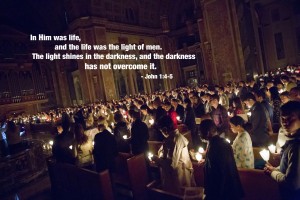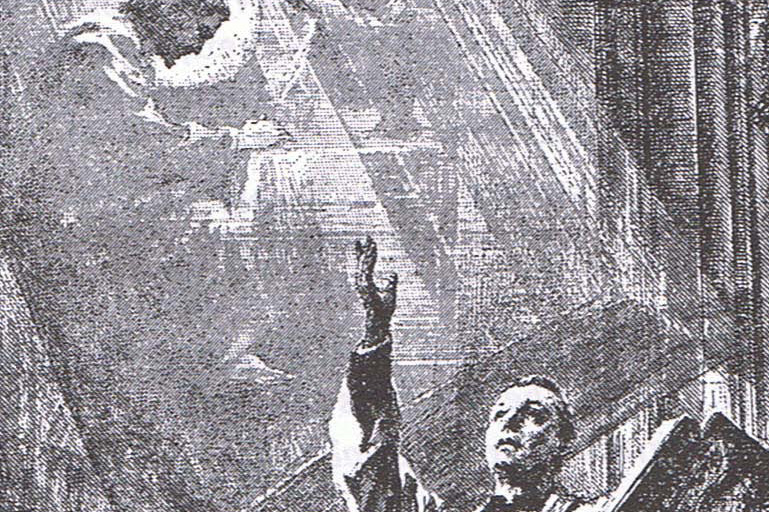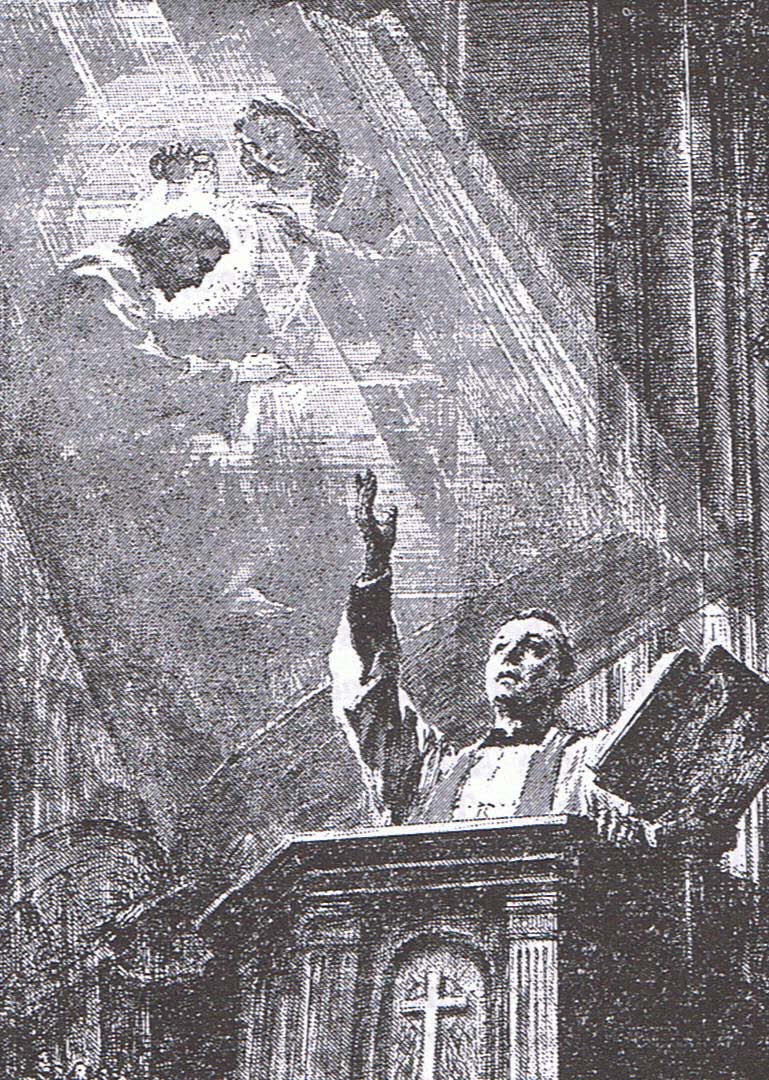 Personal Testimonies are supposed to be three to five minutes. I suspect that my written version of how I met Jesus violates that rule. But, since many of you have known me a while, I think that I have to add a few details that I don’t when I am speaking to people who know less about me.
Personal Testimonies are supposed to be three to five minutes. I suspect that my written version of how I met Jesus violates that rule. But, since many of you have known me a while, I think that I have to add a few details that I don’t when I am speaking to people who know less about me.
Thus, here is my personal testimony of how and when I met the Lord. I break it into sections so that perhaps you can abbreviate your reading where necessary. The over arching truth of my life is that the Lord kindled a fire that did not die away, despite trials and personal failings. Thanks be to God, here is how I met Jesus.
I. Death to life – I know by faith that I met Jesus the day I was born. I know this because I was baptized the day that I was born. Having complications with something called “RH factor” in my blood, it was likely I might not survive the day, so the priest was summoned and I was baptized at once. It was July 10, 1961, St Francis Hospital, Evanston, Ill.
And thus, Jesus came, and saved my soul, he also saved my life in this world. For here I am, still alive all these years later.
And though I know by faith, that I met him that day, I have no memory of it. But indeed, he did establish a powerful relationship with me at that moment. I say this because my earliest memory is of talking with Jesus. I have a few memories from early childhood but my clearest and oldest memories were of how Jesus spoke to me.
I think I was approximately five years old. There was a Sacred Heart statue in my room. It was unique because the Lord’s robes were not red, but blue. And in my room I could go, and the Lord spoke to me, tenderly, and in the way a five-year-old could understand. I do not say that the statue talked, it did not, but it did signal the Lord’s presence, and I always knew that I could go to my room and there experience the Lord’s presence and talk with him.
I also want to be clear, Jesus was not just some “imaginary friend.” I had those as a child, and I knew the difference. Jesus was real, and He spoke to me in a different way. I knew I was not making it up, that he was initiating it. With my imaginary friends, I ran both sides of the conversation. But Jesus was no imaginary friend, he was someone who was quite real, who loved me, and spoke tenderly to me.
Yes, these are my earliest memories. At the dawning of my life, my first memories are that Jesus was already there in a relationship with me, simple, intimate, and very reassuring.
II. Dormition – I do not know when or why exactly, but this connection ended. I have a sad memory, though vague, of speaking to an adult in my life, (probably my mother) and explaining that Jesus had gone. I remember even offering some sort of explanation, that perhaps he had to go help other people who need his help more.
This was a time in my life where I began to discover there was a very big world out there, and there were some very awful things happening there. Perhaps my clinging to Jesus seemed selfish. But I attributed his disappearance to the fact that others “needed his help more.”
My awakening in regard to the worse sufferings of others happened when I heard that my father had to go to a far away place called Vietnam, where people were killing each other. Things were very sad there, and there were many orphans and much sorrow.
I was seven years old when my daddy left for the war. And I don’t know if there’s a direct connection, but it was at that time that mysteriously I stopped experiencing Jesus so personally. Yes, I figured he had to go help someone else. I knew Jesus was up in heaven, and I knew he knew and cared about me still, but I no longer heard his voice.
III. Deepening Darkness – At this point, my spiritual life and relationship with the Lord went into remission. I went through the motions: First Confession, First Communion. I knew I was receiving Jesus, but my relationship was less personal, more theoretical, more intellectual.
My father came back from the war, a changed man somehow, sadder and with more anger. My family was uprooted from my boyhood home in North Chicago, as my father’s next duty assignment was down in Florida.
My spiritual dormition (sleep) deepened, and soon enough became a great darkness. At age 10, (1971) as a result of several family crises, I began having my first panic attacks and I remember once saying to my mother that I understood what older people meant when they said that life was hard. I did not think at that time I wanted to live long, and hoped to die young.
As I edged towards my teenage years, I went from being a fretful child, to a teenager often plagued by bouts of severe anxiety and phobias: I feared fire, home invasion, and domestic violence. My parents sent me to a counsellor, and I was placed on psychotropic meds for the first time.
I prayed little in these years and though required to attend Mass, I was uninspired by it, and almost never thought of God or had any interest in things spiritual. My spiritual sleep was all but complete, and the darkness of my anxiety also began to manifest as well as intense anger. Loud and angry rock music connected with my soul and gave voice to my anger and the rebellious spirit of my early high school years.
I developed hostility to things religious, to the Church, to the Bible, and I did not like being told what to do. In a sense, this was typical teenage rebelliousness, but I was about as far as I could be from those early tender years when Jesus used to speak to me quietly in my room.
IV. Dawning – And then Jesus called! I didn’t know it at first, but it was him, I know it now.
Among the “curses” in my life at that time was having to go to Mass on Sunday. And then one day, a high school choir formed at the Church that I attended, and I noticed there were very pretty girls in the choir. I could not sing at all, and did not like to sing, but I accepted an invitation to join the choir to meet the girls.
And I did meet them, and dated two of them seriously, and several of them more casually over the 4 to 5 years that followed. Strangely, I actually began to like the music, and was impressed with the sound of the mighty pipe organ.
I was not praying yet, I was still not spiritual, but through the goodness, truth and beauty of the music (and yes, the girls) The Lord was calling. The darkness had not passed, but light was on the horizon.
V. Development – I cannot fully develop every step which took place, but in varying stages in late high School and early College, I became cantor, the Church choir director, and an organist. That led to liturgy planning, studies of God’s Word, and entering more deeply into the life of the Church.
A strange and uncomfortable yearning began to develop within me, for though while completing my computer science degree and already working for the Army Corps of Engineers, and while dating a girl I intended to marry, a strange desire for the priesthood began to dawn on me. And it was strange. I was not really praying all that much, and I was working for a pastor in Virginia I did not respect. But in your twenties, sometimes you think you can make a difference, and somehow the priesthood seemed that sort of path for me: something I could do to make a difference.
My college sweetheart, for various reasons, mostly my fault, turned cool on me, and one day, I received my walking papers. One door closed, but I sensed another door still stood open: priesthood. I contacted the Archdiocese of Washington. Within two years, I was walking through the doors of the seminary.
I will not tell you that I had met the Lord again. Not yet, that was still to come. But I entered with pride really, thinking I could make a difference. Yet still, despite my sinful pride, the Lord was still calling.
He reached my mind first. I had entered the seminary poorly catechized, emerging from the “silly 70s” with “butterfly theology” at best. Yet in the seminary, despite dreadful dogmatics, and certain dubious scriptural classes, there were some very wonderful teachers and classes: Liturgy, Patristics, Church history, and Moral Theology were all solid. And that lit up my mind with joy. I supplemented the shortcomings of some of the scripture classes, and the dreadful dogmatics with wonderful books like Ralph Martin’s Crisis of Truth, and Fr. James O’Conner’s The Father’s Son, and The Hidden Manna etc.
Suddenly the beauty of Catholic truth entered the vacuum of my silly 70s mind, and I could hear the voice of Jesus speaking through Scripture and Tradition. I was thrilled with this wisdom, and the great deposit of faith. I was hungry and spent long hours in study. I graduated at the top of my class at Mount St. Mary’s.
But I still cannot say I had yet met Him again. Surely I heard his voice mediated through Scripture and Tradition but it was still not the same as that young boy at five years of age who knew Jesus very personally, that was still yet to come. In Seminary years I prayed an hour each day, but it was a struggle to really experience God at all during those times of prayer.
The Lord reached my heart in my deacon year. It was my canonical retreat, prior to ordination to the priesthood, and Fr. Francis Martin came to the seminary and set forth for us a powerful and cogent proclamation, that through the Word of God and the Sacraments, The Lord Jesus revealed himself to us, and invited us into a relationship that could and would totally change our lives, wherein we would see sins put to death and every virtue come alive.
And so, my heart was on fire and in every liturgy, every proclamation of the Word I began to hear the Lord Jesus, and experience His powerful ministry. My life to begin to change, I saw many sins put to death, and many graces come alive.
But still, I will not tell you, though having a new mind and heart, I had met him again. I knew him through his Word, and through the effects of his sacraments in my life. I knew by faith he existed, but I had not yet met him again. But he had my mind and my heart, and I was well along the path of what the mystics call “the purgative way.”
One final, and painful stage awaited me before I met him again.
VI. Distress – My early years of priesthood, were not without struggles, but they were largely pleasant and productive. Yet, my long history of anxiety and my tendency to fret continued to plague me.
An early promotion to the pastorate, seemingly a great compliment, plunged me into a period of great distress. Panic attacks, and unremitting anxiety robbed me of sleep for weeks, then into months. Demons found an easy doorway and added to my crisis, such that I became despondent. A dark presence enveloped my room, tormenting me and further robbing me of sleep.
It was clear I could not take up my pastoral duties, and I found myself to St. Luke’s Hospital for a week of mental evaluation. And yet, in this great crisis, through this great distress, there seemed to come some purification.
VII. Deliverance – Shortly thereafter, one morning in my holy hour I was praying,… and there he was! It was November of 1994, I was 33 years old.
I cannot describe to you his glory, for it is beyond words, analogies or pictures. Words like spaciousness, openness, wideness, glorious light, and deep serenity come to mind, but they are wholly inadequate. But there he was.
I said nothing, and He said nothing, yet everything was communicated. Words were not necessary at all. It was Cor ad cor loquitur (Heart speaking to heart). Here was what the mystics call “contemplative prayer,” or at least the first murmurings of it. Beyond words or images, not the devoid of them, but beyond them.
Yes there He was and I with him. I had met him again, whom my heart sought, and my mind delighted in. He was here and I with him.
Over the years, my experience of him in prayer has deepened. It has also become more gentle. Some days his presence is deeper than others, some days I struggle to see him at all. But quite consistently and faithfully throughout the years I have known his presence.
And as his presence in my prayers has deepened and become more contemplative, it has overflowed into my daily life. Increasingly, I have become a mystic on the move. Throughout the day, I see his presence beautifully displayed his creation, and in so many people I have come to know and love.
I remain startled at those say there is no evidence of God’s existence. His whole creation shouts “I am designed and it is he who holds me in existence.” I am powerfully aware of his presence in my prayer, and throughout the day, also in the liturgy, and in the glory of his Word and Sacraments.
And yet, I cannot forget those years when I knew him not. I am in no way unsympathetic to those who struggle to see him, but thanks be to God, I can say I know him, I have met him (again), and he is very, very real in my life. I feel his presence now, and a moved to tears as I write this.
He has been good to me, and I am so grateful, so very very grateful, that he looked beyond my fault and saw my need.
An old song says “Within our darkest night, you kindle fire that never dies away!” And that is my story, a fire he kindled that never died away, by his grace.
And I’m also grateful, for those who prayed for me in my darkest hours, especially my grandmother and my mother and so many parishioners who saw me through and witnessed to me of the glory of God in their life.
Yes, Jesus is real, I have met him, and speak to him each day in prayer. He kindled a fire in me when I was baptized. I knew it at age five, and strangely lost sight of it. But the fire he kindled never died away. And He, by the fire of his presence is changing my life. I am not what I want to be, but I am not what I used to be.
For all this I am grateful, so very grateful.





